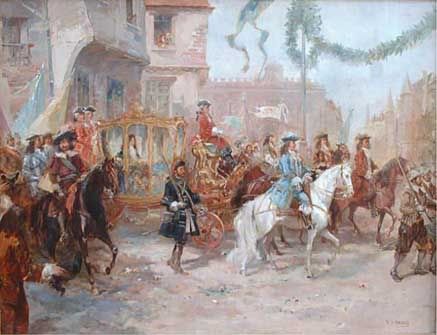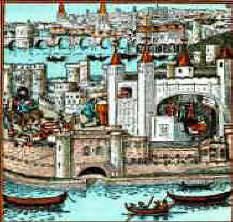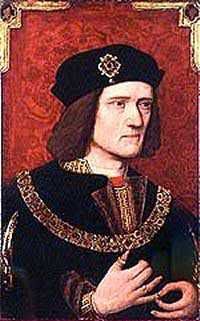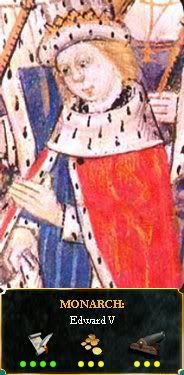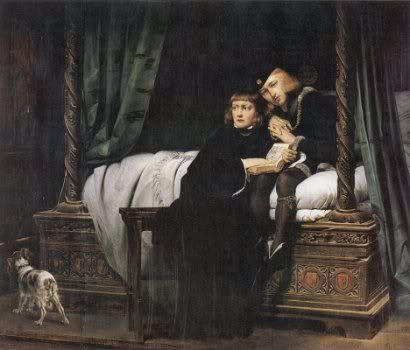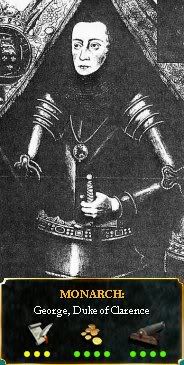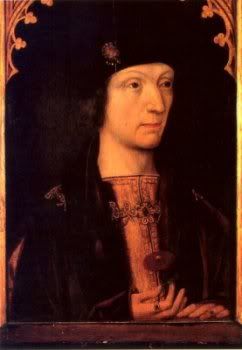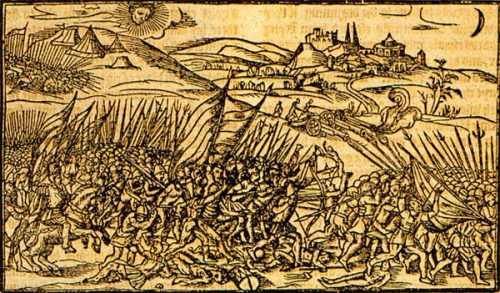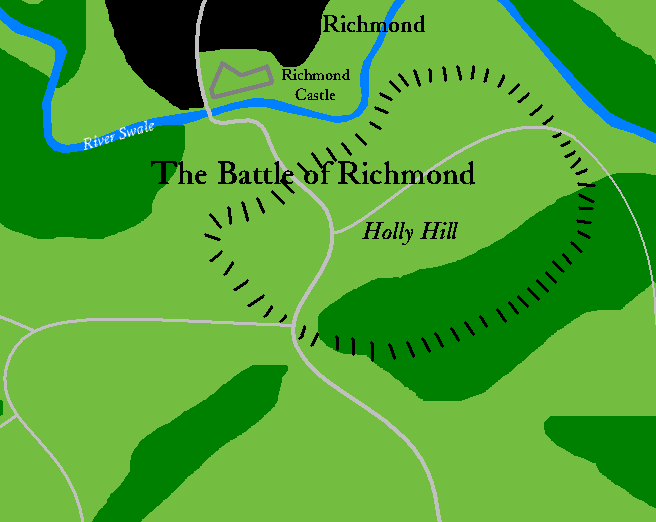Incidental music
Sergei Prokofiev: Romeo and Juliet: Dance of the Knights
Edward V
Born: 2 November 1470, Flushing, Zeeland
Married: None
Died: Unknown, commonly believed June or July 1483, London
Titles: (claimed but unrecognised in brackets)
King of England, Wales, Scotland, Ireland [and France]
Prince of Wales
Lord of the Scottish [and Greek] Isles
Duke of Holland and Friesland, [Iceland and Bretagne]
Count of Guines
In historical events great men—so-called—are but labels serving to give a name to the event, and like labels they have the least possible connection with the event itself... A king is history's slave.
--Leo Tolstoy, War and Peace.
Edward was born during Ioan II's "Readeption", when Edward and his wife were in exile in Holland. It was an inauspicious start for the young prince, and things would not get much better over the years. With the restoration of his father to the English throne in early 1471, he would be made Prince of Wales, a title which the constant turmoil of the previous century had almost gotten rid of: of the kings of the "Welsh" line, only Maelgwn had held the position, and of course Edward IV was never made Prince of Wales.
As Prince of Wales, Edward was also the first head of the Council of the Marches, an administrative body which lumped in the regions of Shropshire, Gloucestershire and Herefordshire (and at times Cheshire) with Wales proper. As such he ruled
sicut regale (like a king), and his first capital was Ludlow in Shropshire. Here he gained some knowledge of administration and the day-to-day matters of a royal court. Had he been born without uncles, he would have been able to apply these admirably; instead, he lived through the turmoil of his father's later reign at the same time as his administration.
It was at Ludlow that Edward heard two important pieces of news: First, in 1478, he heard of the imprisonment and execution of his uncle, Richard of Gloucester. Edward had been close to Richard, and the latter had taken many trips to Ludlow to aid in the education and administration of the young prince. The second piece of news was far more devestating, as a few days after his father's death the news reached the Welsh marches.
Edward, along with his even younger brother Richard, Duke of Cornwall, was rushed to London to become king at the age of 12. Despite this youth things at first appeared auspicious, as he was already showing signs of being quite able and intelligent. The problem was who had rushed him there: The convoy passed through Warwick along the way to London, where George of Clarence was waiting. He intercepted the princes, "escorting" them to the capital and "protecting" them in the Tower of London.
King Edward V and the Duke of York in the Tower of London, by Paul Delaroche (1830)
George hoped to use the young king to advance his own authority. He convened both the privy council and Parliament, preparing for a double proclamation of Edward as king and himself as regent. A person with a somewhat weaker will like his father might have simply become a pawn and remained king that way, but Edward was too intelligent and proud for that. He simply refused to go along with George's attempts to control him, and on 10 June he officially stated that he wished George dismissed and another uncle on his mother's side, Anthony Woodville, Earl Rivers (who had helped him with the administration of the Welsh Marches), as regent.
This infuriated George, and he acted quickly. First, Rivers was arrested on transparent charges of attempting to overthrow Edward and place himself on the throne. Second, George went before Parliament, stating that Edward's marriage to Elisabeth Woodville was void for several reasons (including an earlier promise on Edward's part to marry another woman, and accusations of witchcraft against Elisabeth) and thus their children were illegitimate. The two were carried out simultaneously: On 25 June 1483, Rivers was executed at Pontefract Castle, and Parliament passed the act
Titulus Regius ("The Royal Title"), dispossesing Edward V of the throne and giving it to George.
George (I) Crookback
Born: 21 October 1449, Dublin
Married: [1] Isabel Neville (on 4 July 1469) [2] Anne Neville (on 17 August 1483)
Died: 27 July 1484, Richmond, Yorkshire
Titles: (claimed but unrecognised in brackets)
[King of England, Wales, Scotland, Ireland and France
Lord of the Scottish and Greek Isles]
Duke of Clarence, [Holland and Friesland, Cornwall, Iceland and Bretagne
Count of Guines]
Cursed be he that perverteth the judgment of the stranger, of the fatherless and the widow: and all the people shall say: Amen.
--Deuteronomy, 27:19.
The
coup d'etat of June 1483 was a major shock to England. Worse than the fact that George had taken the throne was the fact that after June 25, neither Edward nor his brother Richard were seen again, a fact that immediately pinned on George the charge of their murder. It may have seemed unneccessary at first to do so, as they had been disinherited, but George did still have a motive: if anyone were to rise against him, they could concievably reinstate their position and use it against George.
That a murder occured is very likely. If George had left them alive, he no doubt would have shown them so in order to stem the rumors that were already going around. If they had died of natural causes, George could have at least attempted to display their bodies in such a state. There is one thing that could exonerate George of the crime, however, and that is the very distinct possiblity that the murder was done at someone else's instigation, and they successfully pinned it on George.
Two other notable suspects apear after analysis. First was Henry Stafford, Duke of Buckingham. Brother-in-law to Elisabeth Woodville by his marriage to her sister Catherine, Buckingham sided with George--he despised the Woodvilles, and thus by extension his nephews in the tower. It is quite possible that Buckingham killed them either out that hatred or to further his own eventual claim to the throne. The other is John, Howard, Duke of Norfolk, whom George had given authority over the Tower and whose title was granted only three days after the previous holder--Richard, the younger of the Princes--had been stripped of it.
Whoever performed the act, it was immediately pinned on George. Within two months of his ascencion to the throne, Buckingham left London and stated that such actions forfeited his position as king, and that he was the only man left with a good enough claim to the throne (through a younger member of the Welsh line). Just as his rebellion was beginning in the south, however, another man was making the same statement: Henry Tewdur, Earl of Richmond.
Henry Tewdur
Buckingham's revolt was the more immediate of the two. George moved quickly, first striking at a small revolt in Kent by the Earl of Sussex, Osric d'Auxonne, in October 1483. He was too hasty in his preparations, however, and a short skirmish on 1 November resulted in a defeat with few casualties on either side. He decided to let that one go when the main revolt appeared in Wessex and Gloucestershire, with Buckingham himself in its head.
The first battle between the two took place near Bristol on the snowy day of 22 December 1483. George, with nearly 30,000 men, vastly outnubmered Buckingham's mere 10,000. It appeared as if it would be an easy fight, but things rapidly turned sour for the king: his army became caught in the snow, and what should have been the destruction of the rebel army and the capture of Buckingham instead resulted in the latter's escape into Wales.
George was forced to content himself with chasing down a rebel army in Wessex rather than foolishly attempt to fight in the Welsh mountains in winter. Buckingham, for his part, had found a region very much willing to support a claimant to the Welsh branch of the throne. Twenty thousand men were on his side by the spring of 1484, and Stafford prepared to accept ten thousand more who were organizing again in Wessex.
They were able to do so because George's attention was distracted northward. Henry Tewdur had collected an army of 9,500 men, centered in his own lands of Richmond. From there he could threaten York, and then move southward. George felt that this was the more pressing problem, and began to try and quash the rebellion there.
His first attempt, on 14 April 1484, was not very successful. Near the outskirts of York, the two armies met; Richmond pretended to fall back over the next few weeks, but in fact the main part of his army remained behind. George was well into Northumberland before he realized how horribly he had been fooled, but cut off from his supply lines he could not easily go back. Worse, on 10 June Richmond managed to take York, weakening George's position even more. For the next month and a half the two armies maneuvered, looking for a suitable battlefield.
George finally managed to pull Richmond into battle by taking that man's very base, the town of Richmond itself. On 27 July 1484 the two armies appeared opposite each other, George on Holly Hill across the River Swale from the town and Richmond coming up the roads from the south. It appeared as if Richmond was doomed to failure: George had more than double his number, placed in a good defensive position.
A depiction of the Battle of Richmond
Richmond decided to give battle anyway. He concentrated towards the center, where George himself was with his best troops. If this position could be overrun, then the rest of the enemy could be split and destroyed in detail. Richmond himself, along with his uncle Jasper Tewdur, commanded 5,000 men attacking along one road; the other wing, around 4,000 men, was under the command of John de Vere, Earl of Oxford.
Both sides put up a murderous fire with their respective archers, and the only place where Richmond's men made any progress was on Oxford's side. The real reason for such soon became apparent: When they reached the enemy lines, the commander of George's right wing, Thomas Stanley, sent a messenger under flag of truce offering his services to Richmond.
That he had been considering this for some time can be seen through two pieces of evidence: first, an anonymous message sent to the Duke of Norfolk stating that George would be betrayed, and second, the fact that Stanley's men managed to turn around quickly and smash what little now remained of George's right flank, as well as killing the Duke of Norfolk. About 3,000 of George's men managed to escape to Richmond Castle across the river, which they soon surrendered to the castle's lord; only 1,500 remained to stand with George. Richmond's attack against them was starting to fail, as the earl's own bodyguard was cut to pieces, but before Richmond could share their fate, Stanley arrived.
The Battle of Richmond. Each line is c. 1,000 men.
The person who actually killed George is not known. Richmond himself is unlikely, as is Stanley; whoever killed him, even the most negative sources have him fighting to the end. It appeared as if Richmond was on the quick road to the kingship. The situation proved different, however. Buckingham had his own claim to the throne, and was closer to London. One or the other had to strike first, and that one was Buckingham.
Only a few days after the Battle of Richmond, while away from his army, Henry Tewdur was waylaid by what was claimed to be a large band of highwaymen. His horse was shot and killed, throwing him into the Swale where he drowned. Not long after, Buckingham rode into London and was proclaimed King Henry II.
The common depiction of George as a hunch-backed murderer and villain as can be seen in Shakespeare is of course a considerable exaggeration. He was, however, ambitious to a fault, and did have a bit of an amoral streak to him. If it was he who killed his nephews, then he deserved equally as much of a fate as did King Renaud back in the early 14th century; but if it was Stafford, then a great injustice occured on the field of Richmond, and England was deprived of a potentially great king. Whatever the case, the Battle of Richmond marked the end of the de Cornouaille dynasty, and the beginning of the Stafford dynasty.



